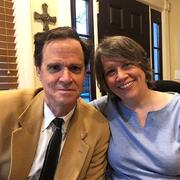
Stephanie Paulsell, Susan Shallcross Swartz Professor of the Practice of Christian Studies at HDS and Interim Pusey Minister in the Memorial Church, interviews her husband Kevin Madigan, Winn Professor of Ecclesiastical History at HDS, about pandemics in the medieval Christian West.
Stephanie Paulsell: If I remember correctly, there’s a bronze statue of the Archangel Michael sheathing his sword on the top of the Castel Sant’Angelo in Rome. Doesn’t that have something to do with a plague?
Kevin Madigan: Yes—the legend is that, during a procession along the Tiber River in plague-stricken Rome in 590, angels sang the hymn Regina Coeli (“Mary, Queen of Heaven”) above the mausoleum of the emperor Hadrian. Pope Gregory the Great, who ordered the procession, is supposed to have responded to their song, “Pray for Us Lord,” after which the archangel atop Hadrian’s tomb sheathed his sword, bringing the plague to an end in the city.
SP: Which plague was that?
KM: It was a form of the bubonic plague that spread from fleas carrying the bacterium Yersinia pestis to rodents and then to humans across Asia, Arabia, North Africa, and Europe during the reign of the emperor Justinian (527-65). It has become known to history as “Justinian’s Plague” not only because he was the emperor at the time, but because he became infected. Justinian survived, but the imperial capital city of Constantinople lost 300,000 lives to it. Overall, Justinian’s plague killed perhaps as many as 50 million people. That was something like one-half the population of the world.
SP: What were the effects of Justinian’s plague on society?
KM: It had a devastating impact on the Mediterranean and European economies. It also profoundly impacted religious life and the future of the religious world in the Mediterranean. Justinian’s grand dream of reuniting the two halves of the Empire, East and West, was destroyed by the plague and, consequently, the Greek and Latin churches remained separated.
SP: Is the bubonic plague the same as the “Black Death”?
KM: The “Black Death”—so-called because the infection turned its victims’ bodies blue-black—was a strain of Yersinia pestis that Genovese merchants brought back in 1347 from the Crimea. The rats on the ship were infected, and by the time the ship reached port in Sicily, the entire crew had perished or were dying. The plague quickly made its way up both the eastern and western coasts of Italy, then to the interior of the peninsula, then north to the rest of Europe, including Scandinavia. The plague spread for three years during which something like one-third of the population of Europe perished.
SP: What was life like during that time?
KM: People withdrew to their homes to avoid infection. But some people spread the disease by fleeing the cities. Boccaccio famously framed the tales of his Decameron with the story of a group of young people who had fled from Florence to a villa in the country to wait out the plague.
SP: What kinds of religious responses were there?
KM: Many saw the plague as an expression of God’s anger against sinful humanity. One of the most extreme religious responses was the appearance of processions of flagellants in the German-speaking regions of Europe, then in France and the Low Countries. In the wake of the plague, flagellants, led by laymen, would process from town to town, singing (a small corpus of medieval flagellant songs has survived) and scourging themselves in an effort to turn away the wrath of God. A typical procession would last for 33 1/2 days, mirroring the years Jesus supposedly lived on Earth. The movement was tinged in Germany by anticlericalist sentiment, then violence against priests, as well as suspicion of heresy: the flagellants claimed to be taught only by the Holy Spirit. Unsurprisingly, they were condemned by papal bull in 1349.
SP: Strange.
KM: Worse than strange. The flagellants encouraged attempts to blame Jews for the plague and instigated violence against them that resulted in the destruction of whole communities. What had begun as a sacrifice intended to redeem and protect the world from catastrophe ended up transforming frustration at suffering into a wave of hateful, deadly scapegoating. The story of the flagellants is a sober reminder of the dangers of fanatical religious movements, and the vulnerability of religious and social minorities in times of social vicissitude.
SP: That’s crucial to remember in these days.
KM: Hatred is its own contagion, as dangerous as any plague.
This piece appeared in the May 7, 2020 edition of "On Pilgrimage," the daily newsletter of Harvard's Memorial Church. To subscribe, visit the Memorial Church website.